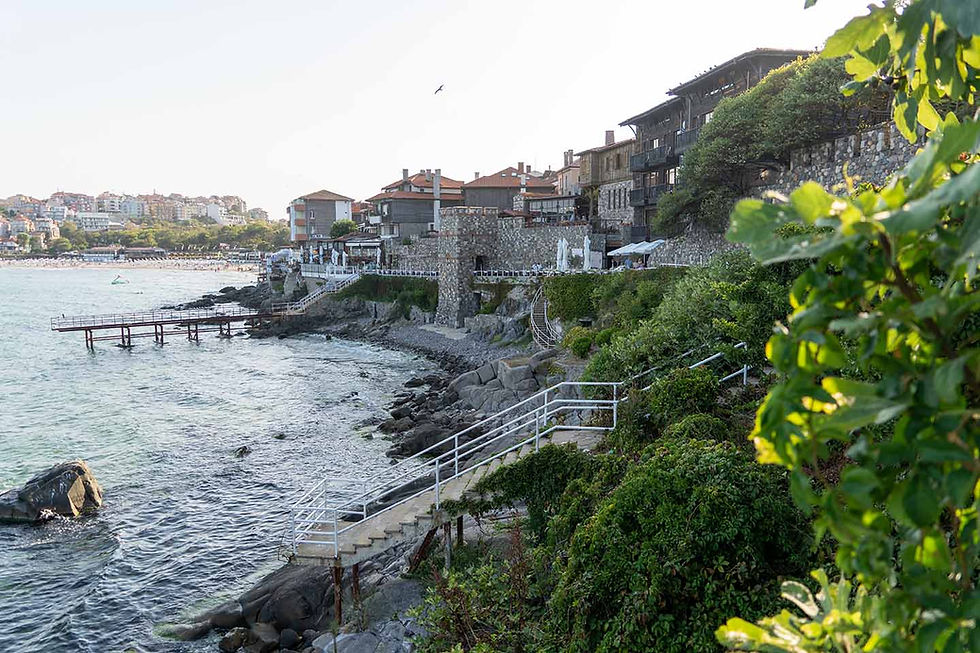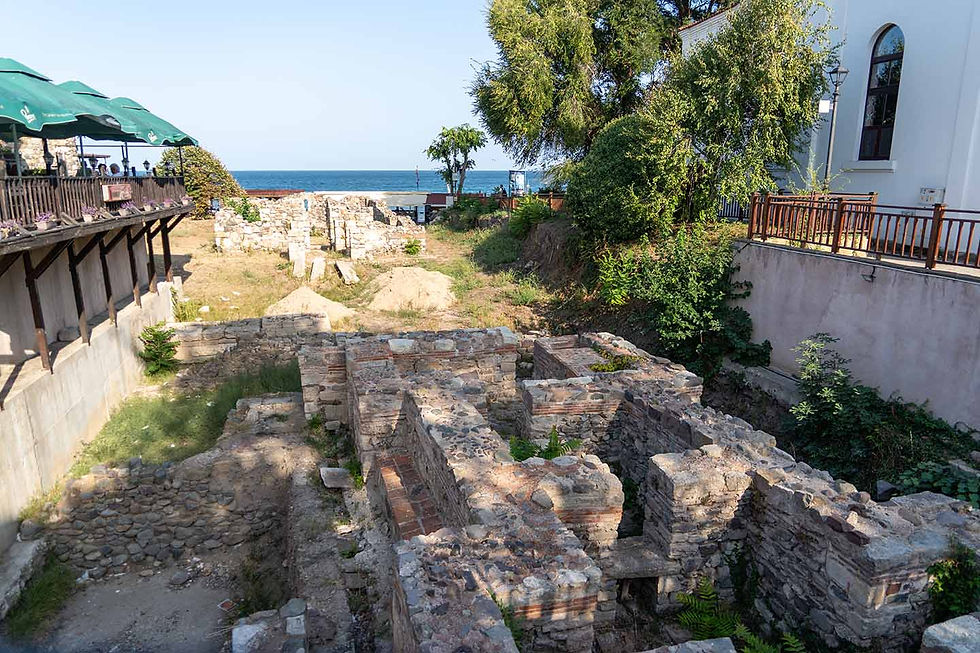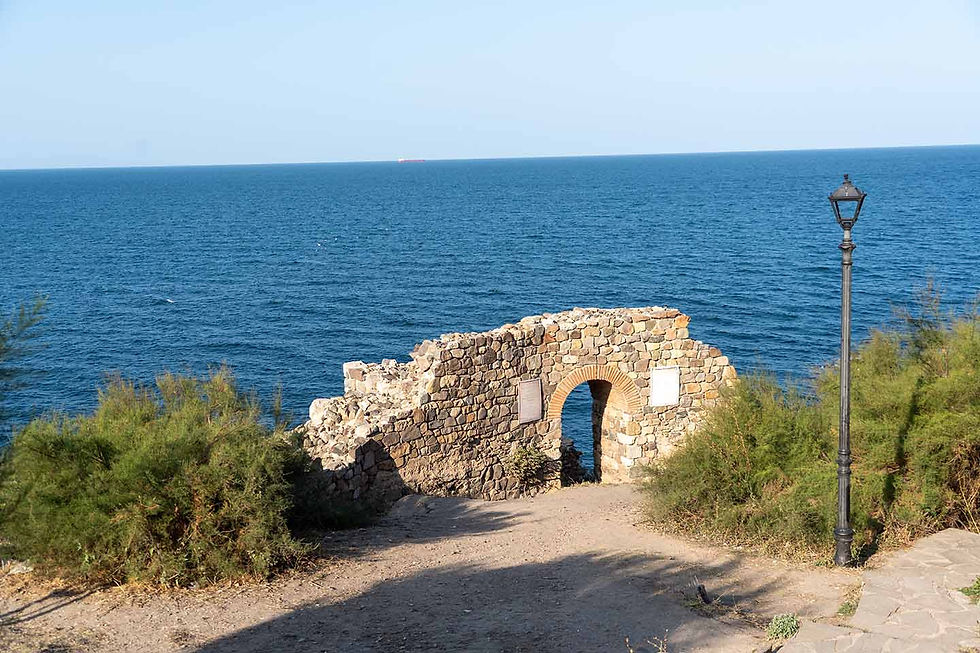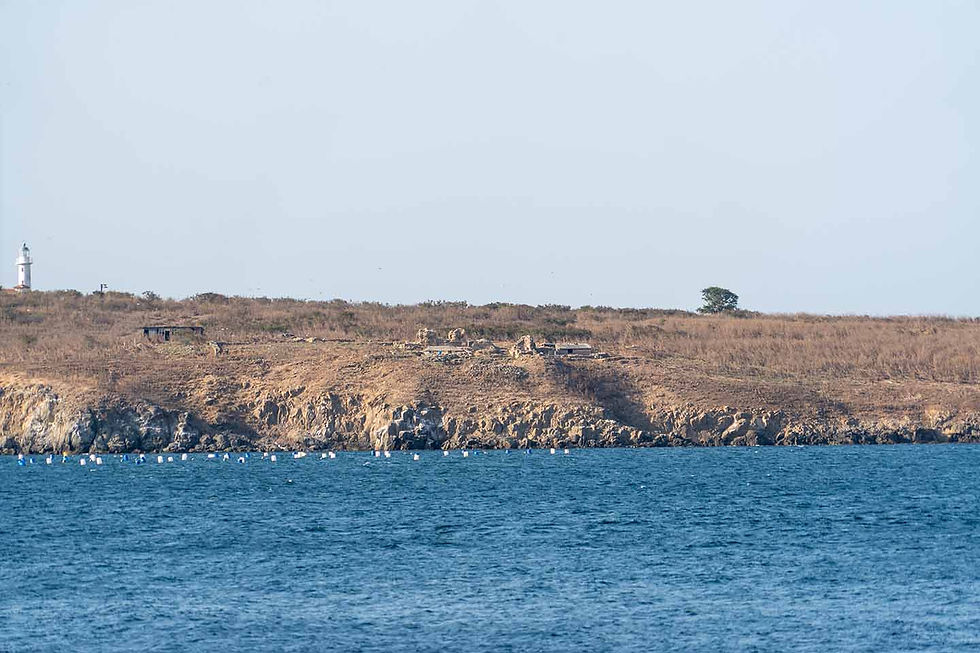Sozopol Architectural, Historical and Archaeological Reserve – Port of Salvation
- Stefan Ivanov

- Sep 4, 2024
- 12 min read
Updated: Sep 15, 2025
Sozopol is not just a town located on the Black Sea coast.

Sozopol is like an exquisite living fabric, woven over the centuries, in which the threads of the past and the present intertwine in a unique, captivating symphony.

With its millennial cultural heritage and impressive historical landmarks, the city manages to preserve the spirit of bygone eras, while at the same time inspiring contemporary artists who gather here for cultural events such as the annual Apollonia Arts Festival.

Every stone, every narrow street, and every view of the sea bear the imprint of a history that is not just a set of facts, but a series of experienced destinies, ups and downs.

This story of mine is a journey back in time that reveals not only the familiar history, but also the hidden connections and messages that Sozopol carefully preserves for those who dare to immerse themselves in its magic.

Sozopol is one of the oldest settlements on the Bulgarian Black Sea coast, whose roots are lost deep in prehistory.

Archaeological research reveals that the first settlers settled in this place as early as the late Bronze Age, and some data even suggest the presence of life as early as the 6th millennium BC.

Underwater expeditions in the waters of the bay reveal remains of ancient dwellings, fragments of ceramic vessels, as well as tools made of stone and bone, dating back to this distant era.

The numerous anchors discovered from the second and first millennia BC are clear evidence of active commercial and maritime activities that have taken place in the bay since ancient times.

This information shows us that the emergence of Sozopol is not accidental. It is evidence of a long, continuous civilizational thread that is the basis of the modern city.

The Greek colonists from Miletus, who arrived later, did not simply found a new settlement, but recognized and took advantage of an already existing and prosperous trading center. Naturally protected harbors were a prerequisite for this early activity, making their choice of location for colonization entirely rational.

This gives Sozopol a sense of depth and continuity, telling the story of a city that was not created from scratch, but was inherited and developed through the ages.

In the 7th century BC, around 610 BC, Greek colonists from Miletus settled in this strategic location and founded a colony, initially called Anthea, and later renamed Apollonia Pontica.
Apollonia Pontica - the greatness of an ancient city
The city quickly flourished as an important commercial and cultural center, establishing strong ties with cities such as Athens, Miletus and Corinth. Apollonia became a legendary commercial rival of another Greek colony, Messemvria (present-day Nessebar), and enjoyed great influence in the Thracian territories thanks to an alliance with the Odrysian Kingdom. At the height of its power, the city was called Apollonia Magna (Great Apollonia).

The central element of the city’s identity and grandeur was the temple dedicated to its patron Apollo, which housed the famous 13-meter bronze statue, the work of the renowned sculptor Calamis. This statue was a unique work of art that impressed its contemporaries. However, its fate is directly linked to the decline of the city. In 72 BC, the Roman legions of Marcus Lucullus took over and plundered Apollonia. As the most valuable trophy, the statue of Apollo was taken to Rome and placed on the Capitoline Hill. This act was more than just a simple robbery – it was a symbolic beheading of the city. After the loss of its cult symbol, Apollonia never managed to fully recover, remaining a small and insignificant city during the Roman period. This story is a vivid example of how cultural heritage is an integral part of the economic and political power of a settlement.
Chronology
Late 4th – 3rd millennium BC – first settlements, active trade, underwater finds from the Bronze Age
7th century BC – Milesian colonists founded Anthea
6th – 1st century BC – Apollonia Pontica flourished as a commercial and cultural center. It was called Great Apollonia. A colossal statue of Apollo was created
72 BC – Apollonia was captured and devastated by the Romans, the statue of Apollo was taken to Rome
1st century AD – the name Sozopolis begins to appear in written sources, reflecting the Christianization of the region
1974 – The Old Town of Sozopol was declared an architectural and historical reserve
1981 – The Ancient City of Apollonia was declared an archaeological reserve.
Middle Ages and Renaissance
After its decline in antiquity, the city found a new path. In the first century AD, the name Sozopolis, which in Greek means "City of Salvation", began to appear in written documents. This change of name reflected a profound cultural and religious transformation - from the pagan cult of Apollo to the Christian faith. The new name gave the city a new, spiritual basis for existence, allowing it to survive the centuries, no longer as a center of commercial power, but as a spiritual refuge.
In 1328, the Byzantine emperor John Kantakouzenos described it as a large and populated city, which testifies to its recovery and importance in the Middle Ages.
In the 19th and early 20th centuries, Sozopol went through a complex historical period. The city was almost entirely inhabited by Greeks, but after the anti-Greek pogroms of 1906, their institutions were closed. Subsequently, in the years after the Balkan Wars, the majority of the Greek population was exchanged for Bulgarians from Eastern Thrace, which is an example of the complex fate of Balkan cities. Despite these ethnic changes, the city managed to preserve its unique atmosphere, and in 1974 its old part was declared an architectural and historical reserve, which officially recognizes and preserves its valuable heritage.
Architectural Heritage
The old town of Sozopol, located on the picturesque Skamni peninsula, was declared an architectural and historical reserve in 1974.
Its appearance is shaped by about 180 preserved houses, built in a characteristic Renaissance style from the mid-18th and early 19th centuries. This architecture is extremely functional and deeply connected to its maritime environment.
The houses are built according to the traditional scheme - with a massive stone ground floor and a protruding wooden upper floor. What distinguishes them from many other Renaissance houses is the special cladding of the second floor, made of long wooden planks. This feature is not just an aesthetic element, but a brilliant example of human adaptation to harsh nature. The wooden cladding provides much greater resistance to the cold sea wind and salty air, protecting the walls from moisture and destruction.
Thus, the architecture of Sozopol is not just a decor, but a living story about the way of life of fishermen and merchants who knew how to cope with the forces of nature. Each house is a unique story, carved from stone and wood, which continues to keep the secrets and memories of the generations that lived in it.
The Old Church of the Assumption of the Virgin
The Old Church of the Assumption of the Virgin is one of the oldest and most valuable churches in Sozopol. It is located in the old town, near the amphitheater and the central part.

The church is believed to have been built in 1450, making it one of the oldest surviving Christian churches on the Bulgarian Black Sea coast. It was built on the foundations of an earlier church from the 6th century, which was part of a monastery complex.
The church is a three-aisled basilica with a low ceiling. This architectural style is typical of the period of Ottoman rule, when Christian churches were not supposed to be taller than government buildings. The walls are made of stone and the roof is made of wood. Architecturally, it is distinguished by simplicity and functionality, typical of the era.

The old church "Holy Assumption of the Virgin" in Sozopol and the house in its courtyard were declared an architectural, construction and artistic monument of culture with a category of national importance in 1962. This status emphasizes its exceptional historical, architectural and artistic value. It is not only a functioning temple, but also an important cultural center that attracts many tourists.

One of the most valuable elements of the church is its iconostasis. It was made in the 18th century by masters of the Debar School and is extremely rich in woodcarving with floral and animal motifs. It is believed to be the work of master Lazar. The iconostasis is a true work of art and is one of the best examples of church woodcarving in Bulgaria.
The iconostasis of the old church "Holy Assumption of the Virgin Mary" in Sozopol was declared an artistic monument of culture with the category of national importance in 1967.
The church preserves valuable icons from the 17th and 18th centuries, which are the work of local icon painters and representatives of the Tryavna icon painting school.

According to local legend, before the construction of the current church, there was a monastery on this site, which was destroyed by the Ottomans. The people of the town decided to raise funds and build a new temple in order to preserve their faith and tradition.
Today, the Church of the Assumption of the Virgin Mary is one of the most important landmarks of Sozopol. It is a testament to the deep roots of Christianity in this ancient town and is an example of the craftsmanship of Bulgarian builders and icon painters from the Renaissance era.
Antiquity and the present - intertwining of eras
The old town of Sozopol is like a book, where each historical layer is a page from the past - visible and tangible.

Despite the predominant Renaissance architecture, remains from more ancient eras are visible everywhere.

Among the alleys and courtyards are archaeological finds, and the remains of the ancient fortress walls still surround the entire Skamni peninsula.

This harmonious symbiosis between Antiquity, the Middle Ages and the Bulgarian Renaissance creates a sense of continuity of history. Sozopol does not simply preserve ruins, but organically weaves them into its modern urban landscape, becoming a kind of living open-air museum, where the past is not closed behind glass windows, but breathes freely along the cobblestone streets.
St. Ivan Island
Located a few kilometers north of Sozopol, St. Ivan Island is the largest Bulgarian Black Sea island.

Its history is filled with mysticism and deep sacredness. The place has been sacred since the time of the Thracians, who used it for ritual purposes. Later, in Antiquity, a large cult complex was built on the island, dating back to the 4th century BC, which probably included a temple of Apollo.

This spiritual continuity continued after the arrival of Christianity. At the end of the 4th and beginning of the 5th century, an early Christian basilica was erected on the ruins of the Thracian sanctuary, which later became the monastery of "St. John the Baptist".

The monastery established itself as an important spiritual and literary center during the Middle Ages, reaching its peak during the Second Bulgarian Kingdom.

The culmination of this long spiritual history was the discovery made in 2010, when a marble reliquary containing the relics of Saint John the Baptist was found during archaeological excavations in the altar section of the early Christian basilica.

This sensational discovery immediately turned the island into a place of pilgrimage of international importance. A number of scientific studies confirmed their authenticity.

The island's history is a perfect metaphor for Bulgaria as a crossroads of civilizations, where each successive culture builds its spiritual heritage on the foundations of the previous one, preserving the sacredness of the place throughout the centuries.
St. Peter Island
About 50 meters east of Sveti Ivan lies the smaller island of Sveti Petar, also known as Sveti Petka.

Archaeological research has established that in ancient times the two islands were connected into one. Like the neighboring island, Sveti Petar is also part of the nature and archaeological reserve, and traces of a Thracian sanctuary and ruins of a chapel from the Bulgarian Renaissance have been discovered on it.

In addition to its rich past, the island is also known as the "Bird Island", as it is home to the largest colony of herring gulls in Bulgaria. This duality between archaeological history and its modern status as a nature reserve shows that the history of Sozopol is inseparable from its unique nature.

The territory of the islands of St. Ivan and St. Peter and their adjacent waters near Sozopol were declared archaeological reserves in 2001.
The Peninsula of St. Kirik and Julita - from a Fishing School to a Naval Base
The Peninsula of St. Kirik and Julita, which is today connected to the mainland by an artificial causeway and a breakwater built in 1927, hides one of the most intriguing stories of the city.

On the site of the ruins of a medieval monastery, construction of a Practical Fishing School began in 1925, designed by the famous Burgas architect Stoyan Nikolov. The school, officially opened in 1930, has a modern base, expensive instruments and even its own ship for practical training.
The deepest secret of this institution lies in its true mission.

The school was not created solely to train fishermen. It was a strategic response to the provisions of the Treaty of Neuilly-sur-Seine of 1919, which imposed restrictions on naval education in Bulgaria. By establishing the Fishery School, the state elegantly circumvented these international restrictions, training personnel for its navy under the guise of a civilian institution. This story is an outstanding example of national ingenuity and perseverance in one of the most difficult periods in Bulgarian history.

Furthermore, the fact that the school provided full board and educated orphans adds a strong emotional dimension to this strategic story, making it a place that gives hope and a future to young people in difficult times.
Chronology
Middle Ages – the island was home to the monastery of "St. St. Kirik and Julita", subordinate to the monastery on the island of St. Ivan
1925 – 1934 – Fishing School, built and functioning as a Practical Fishing School, strategically bypassing the Treaty of Neuilly
1936 – 2005 – the school was rebuilt into a Naval Academy and later into the main southern base of the Bulgarian Navy
1965 – The ancient settlement on the island of St. Kirik was declared an archaeological and architectural-construction monument of culture from Antiquity and the Middle Ages with the category of national importance
2014 – The building of the Fishing School was declared an architectural-construction and historical monument of culture with the category of national importance
2022 – The island of St. Kirik and Julita was declared an archaeological, architectural and historical monument of culture with the category national significance.
Contemporary significance
After many years as a closed military zone, today the peninsula is experiencing a new transformation. The former school building has been declared an immovable architectural asset and has been handed over to the Ministry of Culture, with the ambitious plan to become a future museum of maritime culture and underwater archaeology. This ongoing adaptation – from a monastery, through a clandestine academy and military base, to a future cultural center – is indicative of the dynamic history of Sozopol. It is a place that is constantly reinventing itself, but always remains deeply connected to the sea and its enduring history.
Sozopol – a city living in antiquity
Sozopol is more than a tourist destination; it is a place where history is not a frozen past, but is alive today. Its architectural, historical and archaeological heritage reveals fascinating truths about the continuity of civilizations.

From prehistoric roots, through the grandeur and symbolic tragedy of Apollonia, to the spiritual transformation in Sozopol, the city has gone through the centuries, constantly rediscovering its identity.

Renaissance houses are not just beautiful buildings, but an expression of human ingenuity and a deep understanding of the marine environment.

The islands of St. Ivan and St. Peter tell an incredible story of spiritual continuity - from Thracian sanctuaries, through ancient temples, to Christian monasteries, culminating in the discovery of sacred relics.

The fishing school on the peninsula of St. Kirik and Julita is a remarkable example of national courage and resourcefulness in the face of historical challenges.

Sozopol is one of those places that teaches us that history is not only in textbooks, but also in the whisper of the wind, in the salt on the walls of old houses and in the endless blue of the sea. Its heritage is priceless and it is our duty to preserve it and continue to tell its inspiring story.
How to get to Sozopol?
Sozopol is located:
420 kilometers (about 4 hours and 13 minutes by car) from the capital
286 kilometers (about 3 hours and 2 minutes by car) from the city of Plovdiv
164 kilometers (about 2 hours and 54 minutes by car) from the city of Varna
34 kilometers (about 32 minutes by car) from the city of Burgas
In Sozopol you can visit the Sozopol Archaeological Museum, which preserves and presents the rich cultural and historical heritage of the thousand-year-old city.
You are reading a blog without advertising – completely focused on the content!
I remind you that you can read all my publications here – in "Photo Moments", without being interrupted by a single annoying advertisement, because "Photo Moments" is a place without advertisements!
I made the important decision to make "Photo Moments" ad-free, so that my site can load much faster, the content I present to you can be as clean as possible and your experience in "Photo Moments" can be the best possible!
If you appreciate everything I do, you can support me HERE or by following the gold star below.
Thank you!
And finally, my dear friends,
you shouldn't miss checking out
the special photo album with moments –
discovered, experienced, filmed and shared with you!






















Comments